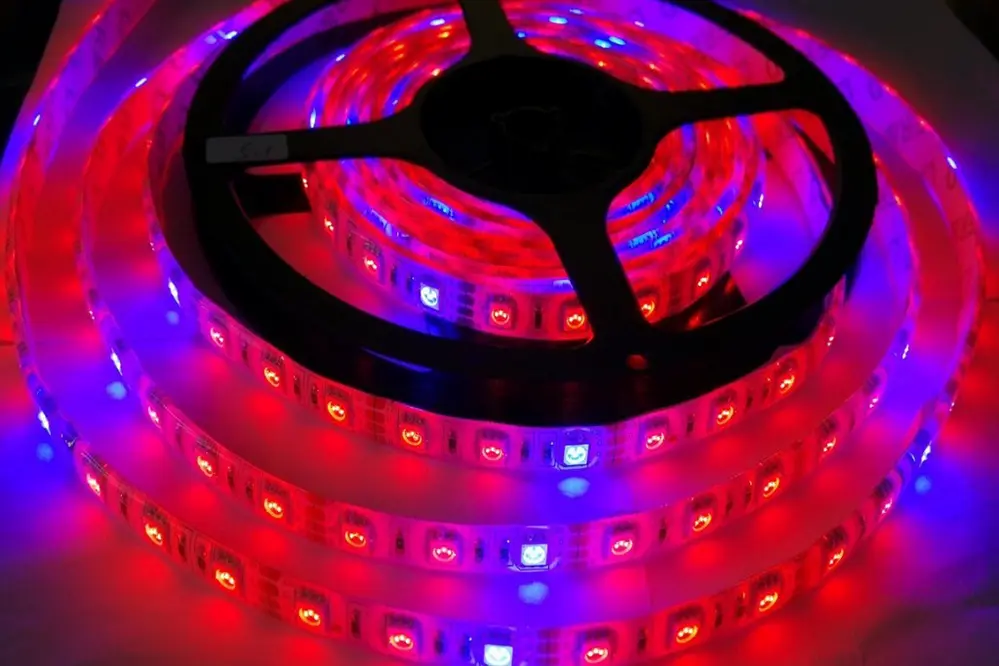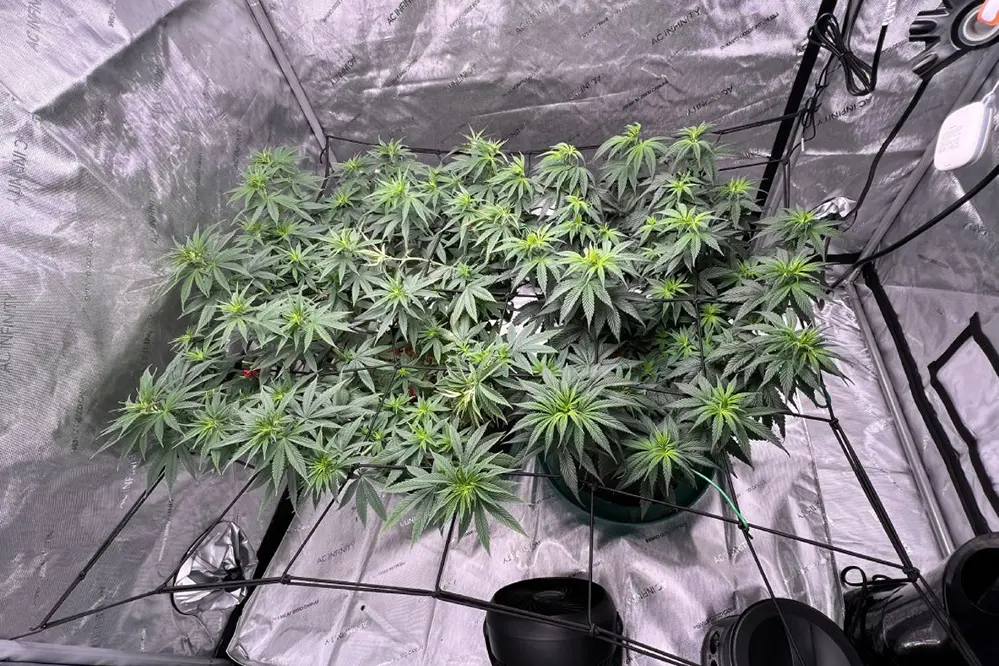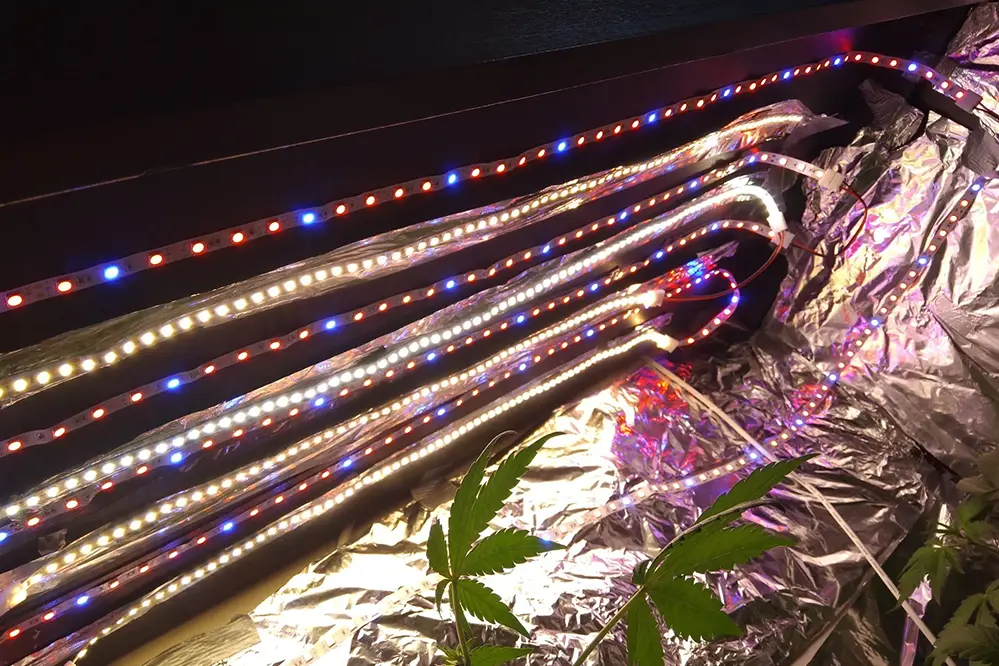Discover the potential of LED strip lights in cannabis cultivation. With advancements in lighting technology, many growers are curious about the effectiveness of these lights for indoor gardening. Let’s explore their capabilities and limitations.
LED strip lights can support cannabis growth, but they may not be as effective as specialized grow lights. They provide adequate light for small-scale or supplemental use but often lack the intensity needed for optimal plant development.
Dive deeper to understand how LED strip lights compare to other lighting options and learn how to maximize their potential in your grow setup.
Understanding LED Strip Lights

LED strip lights can grow weed.
Comprised of multiple tiny light-emitting diodes (LEDs) mounted on a flexible circuit board, these lights are designed to offer a range of brightness and color spectrums. They have emerged as a transformative tool across various industries, including gardening, where they have the potential to emulate natural sunlight. Consequently, their role in the realm of horticulture is gaining momentum as they provide numerous advantages over traditional lighting systems.
Their efficiency and versatility make LED strip lights appealing.
LED strips are cost-effective to operate and maintain, providing long-term financial savings that growers find enticing. Furthermore, they are notable for their energy efficiency and low heat output, mitigating the risk of plant damage while promoting healthier growth environments.
The innovative design of LED strip lights contributes to their adaptability, allowing cultivators to optimize their usage to enhance plant production. Gathering insights from the latest research in LED technology as of the latest year, this pursuit of innovation promises to elevate lighting solutions, offering growers cutting-edge means to support their cannabis cultivation endeavors.
Basic Requirements for Growing Weed

To successfully grow cannabis, one must consider several crucial factors that directly influence the plant’s development and yield.
Among these factors are light, water, nutrients, temperature, and air circulation.
Lighting is of paramount importance as cannabis plants require specific spectrums and intensities of light to flourish at each stage of their growth cycle. Insufficient lighting can lead to suboptimal outcomes, emphasizing the need for a deliberate selection that includes potential tools like LED strip lights, which offer innovation, efficiency, and adaptive capabilities.
Moreover, ensuring your cannabis plants have consistent access to the right blend of nutrients and a stable climate is vital. By establishing a harmonious environment, one can create conditions that not only foster robust growth but also maximize potential yield. In this pursuit, consider the utilization of LED strip lights as a “secret weapon” to achieve your gardening aspirations, opening the door to thriving and sustainable cannabis cultivation.
Can LED Strip Lights Support Plant Growth?
LED strip lights are gaining popularity for home growers due to their flexibility in configuration and energy efficiency, making them a strong alternative to traditional grow lights. But can they effectively nurture plant growth and development?
In recent years, researchers initiated a study focusing on horticultural lighting, exploring how different light spectra and intensities impacted plant growth across various stages. This research revealed promising results with LED lighting, highlighting its potential advantages for home cultivation.
However, it is crucial to note that LED strip lights need to be configured to emit the specific wavelengths of light plants need throughout their life cycle. Particularly for cannabis, the importance of full-spectrum LEDs cannot be overstated, as they are designed to mimic natural sunlight, offering balanced red, blue, and other essential wavelengths.
Considering the adaptability of these lights, while they may not match high-intensity options like HPS or dedicated grow LEDs, they serve remarkably well for small-scale or experimental setups. With intentional installation and optimization, LED strip lights can indeed support decent growth.
In conclusion, with strategic use, LED strip lights present a viable option for enthusiastic growers keen to explore cannabis cultivation.
Advantages of Using LED Strip Lights
LED strip lights offer a myriad of benefits when it comes to cultivating cannabis in a home setting.
First and foremost, their energy efficiency stands out. LED technology is renowned for consuming significantly less power than traditional lighting methods, which translates to lower electricity bills. This is particularly advantageous for enthusiasts mindful of energy consumption.
Moreover, LED strip lights emit minimal heat. This characteristic reduces the risk of thermal stress to your plants, ensuring a more stable environment with less need for additional cooling systems. This advantage can lead to healthier growth and more robust yields.
The versatility of LED strip lights is another compelling benefit. They can be cut and arranged in countless configurations, making them adaptable to any grow space size or shape. This flexibility empowers growers to optimize light coverage across their cultivation area.
In a nutshell, LED strip lights harmoniously combine efficiency, versatility, and safety, making them an excellent choice for cannabis cultivation at home.
Limitations of LED Strip Lights for Weed

While LED strip lights present numerous benefits, there are certain limitations you should be aware of when using them for cannabis cultivation.
Primarily, the intensity of LED strip lights is a significant concern. Unlike dedicated grow lights, these strips might not deliver the powerful lumens your cannabis plants require during various growth stages, particularly the flowering phase. They are typically designed for ambient and decorative lighting, which might render them insufficient to meet the specific light spectrum and intensity demands of cannabis growing.
Additionally, the spectrum coverage of LED strip lights may not be as comprehensive as that of specialized horticultural LEDs. This limited spectrum can impact the plant’s ability to photosynthesize efficiently, affecting the chlorophyll production and ultimately the yield’s quality and quantity.
For those seeking optimal cultivation results, it’s essential to recognize these limitations and evaluate whether LED strip lights can sufficiently serve your needs. Embracing a combination of advanced lighting solutions, or supplementing LED strips with more intense grow lights, can often bridge these gaps, transforming potential drawbacks into opportunities for growth and experimentation within your cultivation endeavors.
Key Characteristics of LED Strip Lights
LED strip lights are a versatile lighting option, revered for their flexibility, ease of installation, and compact nature that makes them perfect for space-conscious environments.
These characteristics make them an excellent choice for creative lighting applications.
However, when examining their utility for plant growth, one must consider their light output, spectrum coverage, and proper ventilation.
Typically, LED strip lights offer a continuous line of illumination, but their power rating (often expressed in watts) and flexibility can vary drastically.
Choosing the right LED strip light involves understanding power requirements, spectrum efficacy, and desired outcomes, acknowledging that not all LEDs are created equally.
Ultimately, the key is to balance what’s ideal for your plant’s needs to achieve success. Proper customization ensures that your lighting arrangements fulfill both aesthetic aspirations and functional requirements.
Choosing the Right LED Strip Lights
When selecting LED strip lights or grow lights for cultivating cannabis, it’s essential to consider the light intensity, color spectrum, and energy efficiency, as these elements significantly influence growth, health, and yield. High-quality LED strips with full-spectrum capabilities are crucial, simulating sunlight to support photosynthesis throughout the plant’s lifecycle.
Opting for adjustable LEDs also allows for tailored light conditions, maximizing the potential for optimal plant development.
Light Intensity and Spectrum
Successful cultivation hinges on intensity—measured in lumens and PPFD—and the comprehensive spectrum that mirrors the intricacies of natural sunlight.
Plants distinguish between different light spectrums, each of which is essential for optimizing photosynthesis and growth.
LED strip lights extend their capabilities beyond simple illumination, providing unmatched versatility through adjustable spectrums and intensity, essential for fostering robust growth in cannabis cultivation.
Enhanced spectrums not only mimic the sun’s natural array—serving a valuable and nuanced purpose in horticulture—but they also ensure that cannabis plants maximize their photosynthetic potential for a successful yield.
Energy Efficiency Considerations
LED strip lights offer significant energy savings while still providing the necessary illumination and spectrum to grow plants, thus making them an attractive option for eco-conscious cultivators.
In comparison to traditional lighting methods, LEDs consume substantially less energy.
This efficiency means lower electricity bills and reduced environmental impact—a win-win for both your wallet and the planet. Utilizing LED strip lights can facilitate sustainable cultivation practices without compromising on the quality of your cannabis yields.
An efficient energy use not only cuts costs but also aligns with a broader shift towards greener practices—critical in today’s ecologically aware society. As we continue to champion sustainability, adopting innovative solutions like LED technology allows growers to maintain their competitive edge while contributing to environmental conservation. Through these endeavors, LED strips can truly become a “light” for responsible and inspired cultivation.
Comparison with Traditional Grow Lights
Traditional grow lights remain a popular choice.
These conventional systems have long been the workhorse of indoor farming, relied upon by countless growers seeking the perfect combination of intensity and spectrum for their crops. However, they come with a significant trade-off in terms of energy consumption and heat emission, which necessitates additional cooling systems.
In contrast, LED strip lights offer cooler operations.
This reduces the need for extensive HVAC systems – an aspect where LED strips shine, offering growers the opportunity to allocate resources more efficiently. The longevity of LEDs also minimizes the frequency of replacements, providing an eco-friendly and cost-effective alternative.
As technology continues its march of progress, the gap between traditional lighting systems and LED solutions narrows, favoring innovation. Modern advancements in the latest year have vastly improved the efficacy and spectrum range of LED strip lights, positioning them as a formidable contender in the quest for optimal plant cultivation. With these strides, growers can confidently harness the power of LEDs to produce thriving crops while embracing sustainability.
Cost-Effectiveness of LED Strip Lights
In the sphere of agricultural innovation, cost-effectiveness remains a paramount concern for cultivators eager to optimize their resources without compromising quality or yield.
LED strip lights shine brightly on this front, offering affordable solutions.
Their relatively low initial investment, especially compared to traditional lighting methods, opens the door to a multitude of grow operations, whether you’re a large-scale producer or a home-based enthusiast. Here, efficiency doesn’t simply translate to reduced costs; it also speaks to a holistic improvement to operations.
Ultimately, the energy efficiency of LED strip lights leads to a dramatic reduction in ongoing electricity expenses. This affordability enhances the feasibility of vertical farming and urban agriculture setups that are often space and budget-constrained. In this landscape, LED strips present themselves not only as “lights” but as transformative tools that drive innovation.
Tips for Successful Indoor Weed Growth
Understanding the environment is paramount for maximizing the potential of indoor weed growth. Every space is unique and requires tailored approaches.
Begin by selecting the right strain that aligns with your cultivation goals and environmental conditions. Certain strains thrive with less light and nutrients, making them ideal for beginners.
Equip yourself with quality tools to monitor and maintain optimal levels of humidity, temperature, and pH. This precision ensures your plants have the ideal environment to flourish.
Frequent observation and adaptability are your best allies. Stay attuned to your plants’ needs, being ready to adjust your strategies for nurturing their growth.
Patience and diligence weave the path to a successful harvest, transforming your grow space into a thriving oasis.
Do LED Strip Lights Work for Growing Weed?
Yes, LED strip lights can work, though not all LED strip lights are created equal.
Indeed, they provide a promising potential as a supplemental lighting source due to their versatility, cost-efficiency, and low heat output, reducing the risk of damaging delicate seedlings. Many cultivators find them most beneficial during initial growth phases, when minimal light is required. However, if you’re aspiring to achieve a robust yield, it’s pivotal to evaluate whether LED strips can meet the photonic demands of your plants.
Nonetheless, they usually fall short of a comprehensive lighting solution for intense cultivation. In advanced stages of growth, traditional LED grow lights, which offer a full spectrum of light and higher intensity, are better suited to support photosynthesis and blooming processes.
Consequently, an exploratory approach that combines LED strip lights with traditional solutions can unveil surprising synergies, optimizing the growth cycle without excessive cost. This hybrid methodology can empower growers, particularly those with limited space, to orchestrate an enriched environment conducive to flourishing yields.
Conclusion
LED strip lights offer a viable option for growing weed, especially during the early developmental stages. Their energy efficiency and low heat output make them ideal for nurturing seedlings and young plants. However, as plants mature, these lights alone may not meet the increased demands for flowering and peak growth phases.
For experienced cultivators, integrating LED strip lights within a broader lighting strategy can significantly enhance growth outcomes, particularly in constrained spaces. By combining these lights with a robust traditional LED system, growers can create a balanced lighting environment that effectively nourishes their crops.
This adaptive approach highlights the potential of LED strip lights as vital contributors within a well-harmonized lighting regimen. By leveraging both innovative and traditional lighting solutions, home cultivators can overcome limitations and achieve thriving, bountiful gardens.





